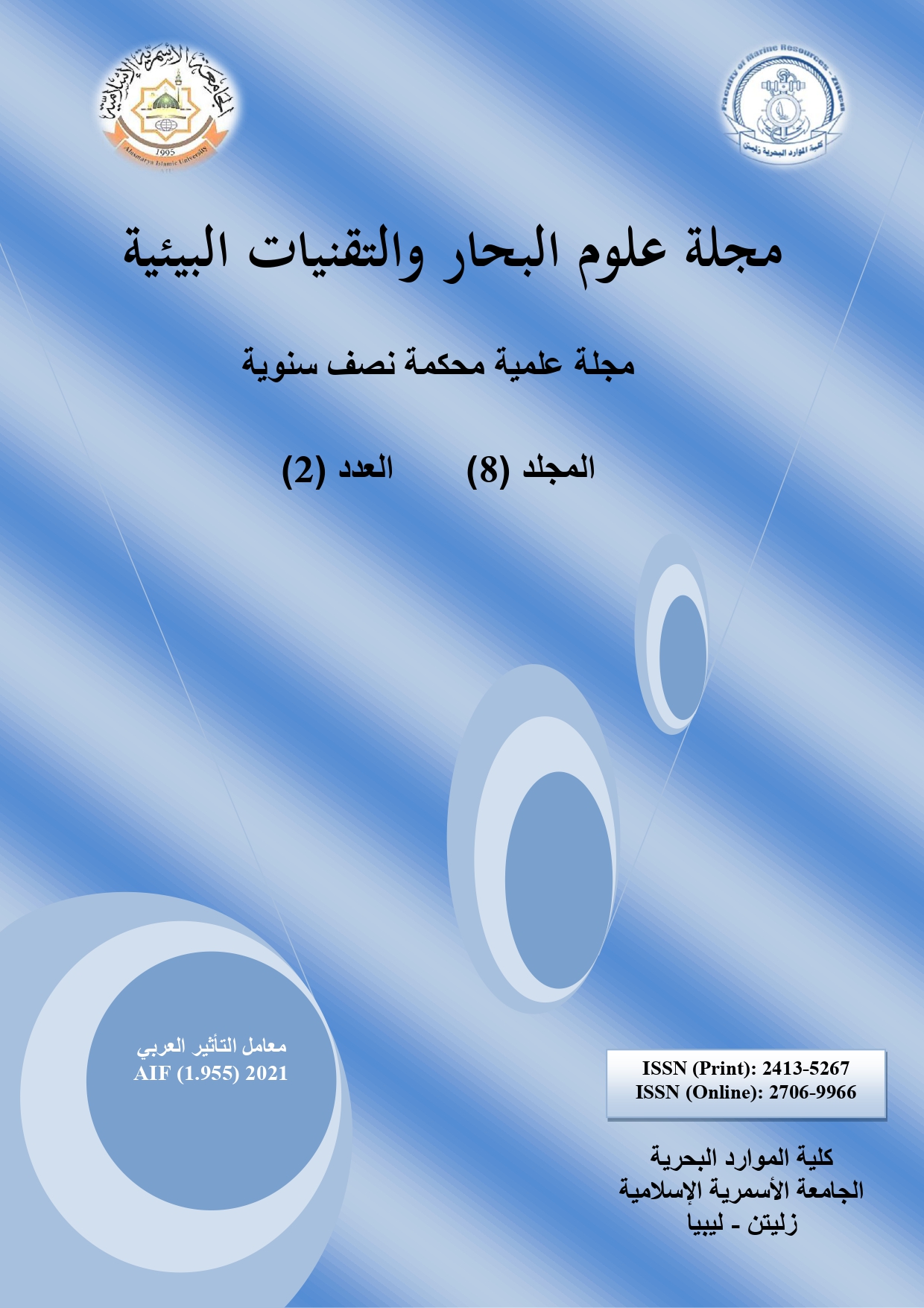تأثير استخدام المتتالي للمخثرات (كلوريد الحديديك أو الشبة) مع الأكسدة الكيميائية بمحلول الفينتون أو الفحم النباتي على كفاءة إزالة المركبات الفينولية والحمل العضوي من مياه الصرف لمعاصر الزيتون
DOI:
https://doi.org/10.59743/jmset.v8i2.63الكلمات المفتاحية:
الشبة، الفحم النباتي، مياه الصرف لمعاصر الزيتون، المركبات الفينوليةالملخص
الخصائص الكيميائية لمياه الصرف لـ 17 معاصرة زيتون في المنطقة الممتدة من منطقتي الدافنية إلى القره بولي درست واستخدمت المخثرات مثل الشبة والكلوريد الحديديك والأكسدة الكيميائية والفحم النباتي لإزالة الحمل العضوي والمركبات الفينولية من هذه المياه. أظهرت النتائج بأن مياه الصرف لمعصر الزيتون ذات حامضية عالية بمتوسط أس هيدروجيني 5.15 ومحتوها عالي من المواد الصلبة بلغ 192 جم/لتر بينما بلغت فيه المواد الصلبة الذائبة 63.5 جرام/لتر وكانت المواد الصلبة العضوية تشكل حوالي 90 % من المواد الصلبة الكلية وبلغ متوسط قيم الأكسجين الكيميائي لهذه المياه 104.9 جم أكسجين/لتر وتركيز المركبات الفينولية عالي وبلغ 1.86 جم/لتر. بالإضافة إلى ذلك، أظهرت النتائج بأن استخدام كلوريد الحديديك كمخثر أعطي نسب إزالة أعلي للمركبات الفينولية والمواد الصلبة الذائبة وللأكسجين الكيميائي المطلوب بالمقارنة مع الشبة في مدي أس هيدروجيني يتراوح ما بين 6-9 وكانت نسبة الإزالة أعلي في الأس الهيدروجيني القلوي وخصوصا للفينولات، كما ازدادت نسبة الإزالة الفينولات والأكسجين الكيميائي المطلوب بزيادة تركيز المخثر من 2 إلى 16 جم/لتر، بينما فاعلية الإزالة للمواد الصلبة الذائبة ضعيفة، مما استدعي استخدام الأكسدة الكيميائية والادمصاص علي الفحم النباتي لزيادة كفاءة عملية الإزالة. بالرغم من أن المزج بين المخثرات الكيميائية والأكسدة الكيميائية أو الأدمصاص على الفحم النباتي حسن من نسبة الإزالة في معاملات الفحم النباتي بالمقارنة مع الأكسدة الكيميائية، إلا أن تركيز الملوثات لا يزال عالياً لتخلص منها وخصوصا للمركبات الفينولية وتحتاج هذه الطرق إلى المزيد من الدراسات لتحسينها. ادمصاص المركبات الفينولية على سطح الفحم النباتي يتبع نموذجي فراندليش ولانجمير إلا أن كمية الادمصاص قليلة بالمقارنة بالأدبيات العلمية لكون هذه الدراسة تستخدم مياه الصرف الخام ذات التراكيز والحمل العضوي العالي مما يسبب تنافس لهذه المواد على مواقع الادمصاص أو يعيقها بترسيبها على سطح الفحم النباتي.
التنزيلات
المراجع
Agalias A., Magiatis P., Skaltsounis A.L., Mikros E., Tsarbopoulos A., and Gikas E. (2007). A new process for the management of olive oil mill wastewater and recovery of natural antioxidants. Journal of Agric. Food Chem., 55(7): 2671–2676.
Al-Meshragi M., Ibrahim H.G., & Okasha A.Y. (2009). Removal of trivalent chromium from aquatic environment by cement kiln dust: Batch studies. In: AIP Conference Proceedings, 1127(1): 74-85. American Institute of Physics.
Andreozzi R. (1998). Integrated treatment of olive oil mill effluents (OME): Study of ozonization cupled with anaerobic digestion. Water Research, 32(8): 2357-2364.
Arabic Organization for Agricultural Development. (2003). Development, production and marketing of olives and olive oil in the Arab world. Reported presented to League of Arab States meeting. Khartoum, Sudan.
Beccari M., Majone M., and Torrisi L. (1998). Two-Reactor System with Partial Phase Separation for Anaerobic Treatment of Olive Oil Mill Effluents. Water Science & Technology, 38(4-5): 53-60.
Borja R., Martin A., Alonso V., Garcia I., and Banks C.J. (1995). Influence of different aerobic pretreatments on the kinetics of anaerobic digestion of olive mill wastewater. Water Research, 29(2): 489-495.
Clesceri L.S., Greenberg A.E., and Eaton A.D. (1999). Standard Methods for the Examination of Water and Wastewater, 20th ed. American Public Health Association (A.P.H.A.), New York, USA.
Coughlin R.W. and Ezra F.S. (1968) Role of surface acidity in the adsorption of organic pollutants on the surface of carbon. Journal of Environ. Sci. Technol., 2: 291–297.
de Ursinos F.R. and Padilla R.B. (1992). Use and treatment of olive mill wastewater: current situation and prospects in Spain. Grasas Aceites, 43(2):101-106.
Di Giovacchino L., Mascolo A., and Seghetti L. (1988). Sulle caratteristiche delle acque di vegetazione Nota 2. La Rivista Italiana delle Sostanze Grasse LXV, 481-488.
Dominguesa E., Fernandesa E., Gomesa J., Castro-Silvab S., and Martinsa R. (2021). Olive oil extraction industry wastewater treatment by coagulation and Fenton’s process. Journal of Water Process Engineering, 39: 1-8.
El-Shafey E.I., Correia P.F.M., and de Carvalho J.M.R. (2005). An integrated process of olive mill wastewater treatment. Separ. Sci. Technol., 40(14): 2841–2869.
Franz M., Arafat H.A., and Pinto N.G. (2000) Effect of chemical surface heterogeneity on the adsorption mechanism of dissolved aromatics on activated carbon. Carbon, 38: 1807–1819.
Ginos A., Manios T., and Mantzavinos D. (2006). Treatment of olive mill effluents by coagulation–flocculation–hydrogen peroxide oxidation and effect on phytotoxicity. Journal of Hazard. Mater, 133: 135–142.
Gomec C.Y., Erdim E., Turan I., Aydin A.E., and Ozturk I. (2007). Advanced oxidation treatment of physico-chemically pre-treated olive mill industry effluent. Journal of Environmental Science and Health, Part B, 42(6): 741-747.
Hamdi M. (1993). Toxicity and biogradability of olive mill wastewaters in batch anaerobic digestion. Applied Biochemistry and Biotechnology, 37: 155–163.
Kallel M., Belaid C., Mechichi T., Ksibi M., and Elleuch B. (2009). Removal of organic load and phenolic compounds from olive mill wastewater by Fenton oxidation with zero-valent iron. Chemical Engineering Journal, 150: 391–395.
Kestioglu K., Yonar T., and Azbar N. (2005). Feasibility of physicochemical treatment and Advanced Oxidation Processes (AOPs) as a means of pretreatment of olive mill effluent (OME). Process Biochem., 40(7): 2409–2416.
Khatib A., Aqra F., Yaghi N., Subuh Y., Hayeek B., Musa M., Basheer S., and Sabbah I. (2009). Reducing the Environmental Impact of Olive Mill Wastewater. American Journal of Environmental Sciences, 5 (1): 1-6.
Kissi M., Mountador M., Assobhei O., Gargivlo E., Palmieri G., Giardira P., and Sannia G. (2001). Roles of two white-rot basidiomycete fungi in decolorisation and ditoxification of olive mill wastewater. Journal of Appl. Microbiol. Biotech., 57: 221–226.
Lucas M. and Peres J. (2009). Removal of COD from olive mill wastewater by Fenton’s reagent: Kinetic study. Journal of Hazardous Materials, 168: 1253–1259.
Mantzavinos D. and Kalogerakis N. (2005). Treatment of olive mill effluents Part I: Organic matter degradation by chemical and biological processes—an overview. Environment International, 31: 289– 295.
Mavros M., Xekoukoulotakis N., Mantzavinos M., and Diamadopoulos E. (2008). Complete treatment of olive pomace leachate by coagulation, activated-carbon adsorption and electrochemical oxidation. Water Research, 42: 2883 – 2888.
Niaounakis N. and Halvadakis C.P. (2004). Olive Mill waste management – Literature review and patent survey. Typothito-George Dardanos Publications, Athens.
Okasha A.Y. and Ibrahim H.G. (2010)a. Phenol Removal from Aqueous Systems by Sorption of Using Some Local Waste Materials. Electrical J. of Environmental, Agricultural and Food Chemistry (EJEAFChe), 9(4): 796-807.
Okasha A.Y. & Ibrahim H.G. (2010)b. Removal of Cu2+ ions from aqueous solutions by adsorption on Libyan soil. Journal of Environmental Science and Engineering, 4(10): 9-15.
Okasha A.Y. Ibrahim H.G., Elatrash M.S., and Marie A.A. (2012). Removal of Cadmium from Aqueous Solutions Using Adsorption Technique: Kinetics and Equilibrium. International Journal of Environment and Bioenergy, 1(2): 105-118.
Rozzi A. and Malpei F. (1996). Treatment and disposal of olive mill effluents. International Biodeterioration Biodegradation, 38: 135-144.
Shaheen H. and Abdel Karim R. (2007). Management of Olive-Mills Wastewater in Palestine. An-Najah Univ. Journal of Research (N. Sc.), 21: 64-83.
Ubay G. and Oztürk İ. (1997). Anaerobic treatment of olive mill effluents. Water Science & Technology, 35: 287-294.
United States Environmental Protection Authority (USEPA) (1979). Toxic Substances Control Act (TSCA), USEPA. Washington, DC.
Yazdanbakhsh A., Mehdipour F., Eslami A., Maleksari H.S., & Ghanbari F. (2015). The combination of coagulation, acid cracking and Fenton-like processes for olive oil mill wastewater treatment: phytotoxicity reduction and biodegradability augmentation. Water Science and Technology, 71(7): 1097-1105.
التنزيلات
منشور
إصدار
القسم
الرخصة
الحقوق الفكرية (c) 2022 مجلة علوم البحار والتقنيات البيئية

هذا العمل مرخص بموجب Creative Commons Attribution 4.0 International License.












